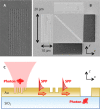Single-plasmon interferences
- PMID: 26998521
- PMCID: PMC4795678
- DOI: 10.1126/sciadv.1501574
Single-plasmon interferences
Abstract
Surface plasmon polaritons are electromagnetic waves coupled to collective electron oscillations propagating along metal-dielectric interfaces, exhibiting a bosonic character. Recent experiments involving surface plasmons guided by wires or stripes allowed the reproduction of quantum optics effects, such as antibunching with a single surface plasmon state, coalescence with a two-plasmon state, conservation of squeezing, or entanglement through plasmonic channels. We report the first direct demonstration of the wave-particle duality for a single surface plasmon freely propagating along a planar metal-air interface. We develop a platform that enables two complementary experiments, one revealing the particle behavior of the single-plasmon state through antibunching, and the other one where the interferences prove its wave nature. This result opens up new ways to exploit quantum conversion effects between different bosonic species as shown here with photons and polaritons.
Keywords: physics; plasmonic device; quantum optics; surface plasmon; wave-particle duality.
Figures


References
-
- Grangier P., Roger G., Aspect A., Experimental evidence for a photon anticorrelation effect on a beam splitter: A new light on single-photon interferences. Europhys. Lett. 1, 173–179 (1986).
-
- Hong C. K., Mandel L., Experimental realization of a localized one-photon state. Phys. Rev. Lett. 56, 58–60 (1986). - PubMed
-
- Neuhauser W., Hohenstatt M., Toschek P. E., Dehmelt H., Localized visible Ba+ mono-ion oscillator. Phys. Rev. A 22, 1137–1140 (1980).
-
- Chang D. E., Vuletić V., Lukin M. D., Quantum nonlinear optics—Photon by photon. Nat. Photonics 8, 685–694 (2014).
-
- Goban A., Hung C.-L., Yu S.-P., Hood J. D., Muniz J.A., Lee J. H., Martin M. J., McClung A. C., Choi K. S., Chang D. E., Painter O., Kimble H. J., Atom–light interactions in photonic crystals. Nat. Commun. 5, 3808 (2014). - PubMed
Publication types
MeSH terms
LinkOut - more resources
Full Text Sources
Other Literature Sources

